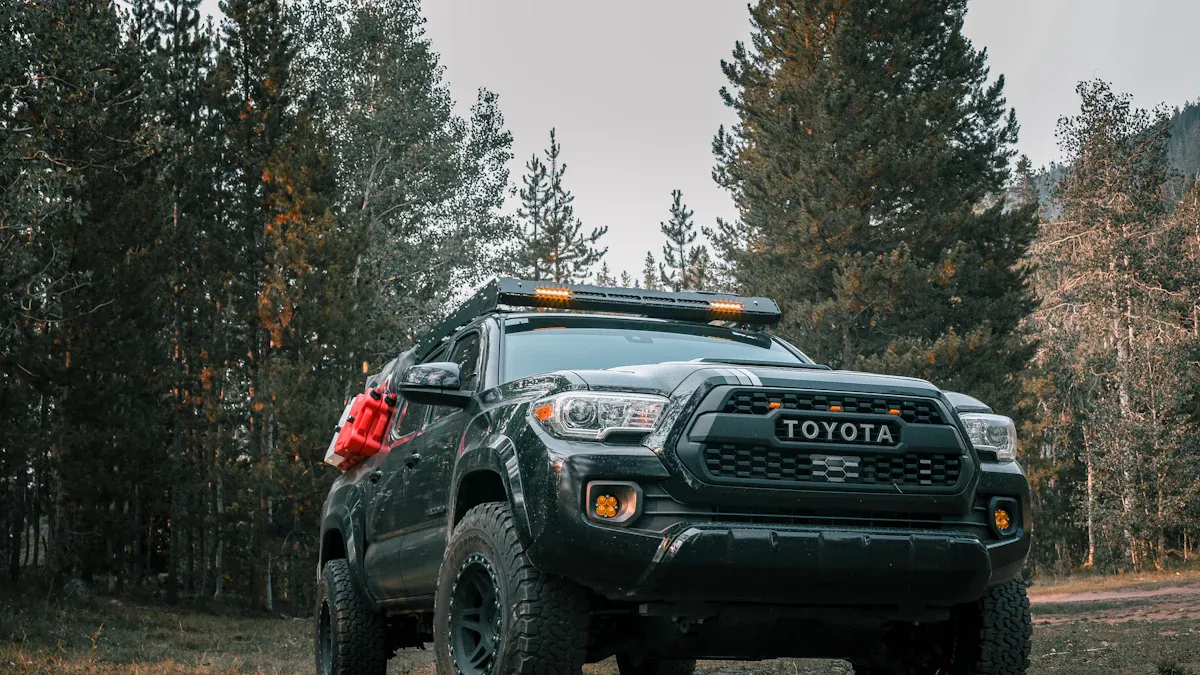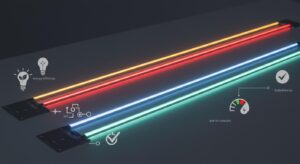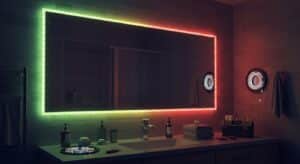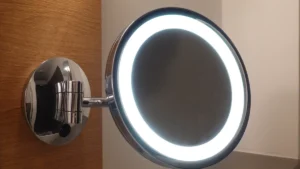
Choosing the right waterproof rigid LED bar makes it last longer. Outdoor and work areas often have tough conditions like rain or dust. Extreme heat or cold can also damage lights. Waterproofing protects the rigid LED bar from these problems. For example, LEDLB-E models are waterproof up to 3 meters. They work in temperatures from -40 to 85 degrees Celsius. This makes them great for very hot, cold, or wet places. Strong rigid LED bars fail less and work better.
Key Takeaways
Pick LED bars with IP65 or IP67 ratings. These protect against dust and water.
Find LED bars made of strong materials like aluminum. This helps them handle heat and last longer.
Use waterproof connectors and mounts that can be adjusted. These make setup easier and keep water out.
Think about your weather when picking LED bars. For very hot or cold places, choose ones that work in both.
Check seals and connections often for any damage. This keeps the LED bar working well and lasting longer.
Why Waterproofing Matters

Protection Against Environmental Elements
Waterproofing helps protect LED bars from weather problems. Rain, storms, and humidity can let water in. This might cause short circuits or damage parts inside. Using waterproof materials and seals stops these issues. It keeps the lights working well.
Moisture can also cause rust in wet places. Over time, this can harm circuits and shorten the light’s life. Adding anti-rust coatings to circuit boards solves this problem. It helps the LED bar last longer, even in tough conditions.
Outdoor lights in hard-to-reach spots are tricky to fix. Repairs can take time and cost a lot. Waterproofing reduces the need for repairs, saving both time and money.
Challenge | Problem | Fix |
|---|---|---|
Bad Weather | Rain and storms can let water in and cause damage. | Use waterproof materials and seals. |
Rust in Wet Areas | Moisture can rust circuits and parts over time. | Add anti-rust coatings to circuit boards. |
Hard-to-Fix Installations | Remote lights are costly and hard to repair. | Waterproofing lowers repair needs. |
Ensuring Longevity and Performance
Waterproof LED lights are made to handle tough weather. They last longer and work better. High humidity can harm regular lights, but waterproof ones resist water. They stay useful for years.
Big temperature changes can also hurt lights. Waterproof LED bars work well in hot or cold weather. They don’t overheat or freeze, which keeps them lasting longer. Setting the right drive current also helps by stopping heat buildup.
Factor | Effect on Life |
|---|---|
Humidity | Waterproof lights resist water, lasting longer. |
Temperature | They work in hot or cold weather without breaking. |
Drive Current | Proper settings stop overheating, making them last longer. |
Uses in Outdoor and Work Areas
Waterproof LED bars are great for outdoor and work uses. At home, they light up gardens, patios, and pools. They work even in heavy rain. Stores and parking lots use them for safety and energy savings.
Public places like streets and parks use LED lights for safety and energy efficiency. Factories and warehouses need waterproof lights to handle dust and water. These lights also help lower costs.
For boats and docks, waterproof LED bars resist saltwater rust. They are perfect for marine areas. Underwater uses like fountains and aquariums also benefit. These lights give bright colors and last a long time.
Use Type | Examples of Use | Benefits |
|---|---|---|
Home Use | Gardens, patios, pools | Reliable lighting in bad weather |
Business Use | Stores, signs, parking lots | Better safety and visibility |
Public Places | Streets, parks, bridges | Energy-saving lights, safer spaces |
Work and Factory Areas | Factories, warehouses | Handle dust and water, save money |
Marine Areas | Boats, docks, marinas | Resist rust from saltwater |
Underwater Uses | Fountains, aquariums, pools | Bright colors, long-lasting lights |
Understanding IP Ratings for Waterproof LED Strip Lights

What Is an IP Rating?
An IP rating shows how well a product blocks dust and water. It is a global standard made by the International Electrotechnical Commission (IEC). The rating has two numbers to show protection levels. The first number tells how much it blocks dust. The second number shows how much water it can handle. For example, an IP67 rating means it is fully dustproof and can be in water briefly.
The word “waterproof” changed to “water-resistant” in 1990 for clarity. Testing rules have improved over time. The ISO 2281 standard from 1990 was updated to ISO 22810 in 2010. These updates made water resistance testing better. Now, IP ratings like IP65, IP67, and IP68 explain waterproof levels for LED bars.
Tip: Always check the IP rating before buying an LED bar. This ensures it has the right waterproof level for your needs.
Decoding IP Rating Numbers (e.g., IP65, IP67, IP68)
The numbers in an IP rating help you pick the right LED bar. The first number goes from 0 to 6 and shows dust protection. A “6” means it is completely dustproof. The second number goes from 0 to 9 and shows water resistance. Higher numbers mean better water protection.
Here’s a simple guide to common IP ratings:
IP Rating | Dust Protection Level | Water Protection Level |
|---|---|---|
IP65 | Dust tight | Water jets from any direction |
IP67 | Dust tight | Immersion in water up to 1 meter for 30 minutes |
IP68 | Dust tight | Immersion beyond 1 meter (specific conditions apply) |
For example, IP65 works well for outdoor areas with rain or splashes. IP67 is good for short water dips, like in pools or fountains. IP68 is best for underwater use, like in aquariums.
Testing happens in labs with pure water. Devices are off during tests. For IPX7, the product is dipped briefly. For IPX8, it is tested for longer underwater use.
Choosing the Right IP Rating for Your Climate
Pick the right IP rating based on your location. Outdoor spots with rain or dust need at least IP65. This protects against water sprays and dust. For heavy rain or short flooding, IP67 is better.
Here’s a quick guide to help:
Application Area | Recommended IP Rating | Description |
|---|---|---|
Outdoor Use | IP65 | Protects against dust and water sprays |
Indoor Use | IP20 | Works for dry places |
Harsh Environments | IP67 | Best for dust and water immersion |
If you live near the coast, choose IP67 or IP68. These protect against saltwater and long water dips. For general outdoor use, IP65 is enough. Match the IP rating to your area for longer-lasting LED bars.
Note: Lower IP ratings, like IP20, are fine for indoor spaces without water or dust.
Key Features to Look For in a Rigid LED Bar
Material Quality and Durability
The material of an LED bar affects how long it lasts. Strong materials like die-cast aluminum help it stay durable. They also manage heat well, keeping the light from overheating. For example, ATC EE Series Light Bars use aluminum housing and tough lenses. These bars are waterproof (IP67) and last up to 30,000 hours. This makes them great for tough weather without losing performance.
When comparing LED bars, check for certifications like SAE J575. These tests show if the bar can handle shocks and vibrations. Class I Compact LED Light Bars use polycarbonate materials for heavy-duty jobs. They also come with a 5-year warranty. Picking a bar with strong materials ensures it works well in tough places.
Model | Material | Lens Material | Waterproof Rate | Lifetime |
|---|---|---|---|---|
ATC EE Series Light Bars | Die-cast aluminum | Polycarbonate (Lexan) | IP67 | 30,000 hours |
Class I Compact LED Light Bars | Polycarbonate | N/A | N/A | 5 Years |
Resistance to Corrosion and UV Damage
Outdoor LED bars face water, salt, and sunlight, which can cause damage. To prevent this, choose bars with anti-rust coatings and UV-resistant materials. Aluminum alloy housings resist rust and protect against sunlight damage. They also manage heat to keep the bar working well.
For boats and docks, pick LED bars that handle saltwater. IP68-rated products are best for these areas. They block water and dust, keeping the bar safe. Choosing these features ensures the LED bar lasts longer in harsh conditions.
Brightness and Energy Efficiency
Brightness and energy-saving features are important for LED bars. Some models let you adjust lighting modes and settings. For example, certain bars have 27 modes and over 300,000 configurations. This lets you customize the light for your needs.
Energy-efficient LED bars use less power but stay bright. They work well for homes and businesses. Safety features like brake and turn signals make them useful for vehicles and work areas.
Feature | Description |
|---|---|
Pre-Programmed Modes | 27 different modes for customizable lighting options. |
Programmable Triggers | Running and three auxiliary triggers for enhanced functionality. |
Safety Features | Supports running, brake, reverse, and turn signal functions. |
LED Color Options | Available in red, white, blue, green, and amber. |
By focusing on these features, you can find an LED bar that is bright, energy-efficient, and reliable.
Waterproof Connectors and Mounting Options
Waterproof connectors and mounts are key for reliable LED bars. They make setup easier and protect the bar from damage. These features are crucial for long-lasting use.
Waterproof connectors stop water and dust from harming parts. This is very useful outdoors or in places with lots of moisture. Good connectors often have rubber seals for extra protection. For instance, IP67 connectors can handle being underwater for 30 minutes. This keeps your LED bar working even in wet areas.
Mounting options are also important for proper installation. Adjustable brackets let you change the LED bar’s angle for better lighting. Strong materials like aluminum make brackets tough for rough conditions. Many brackets also resist scratches, staying strong and looking good. Adjustable mounts help you attach the bar to vehicles, buildings, or boats.
Tip: Pick LED bars with waterproof connectors and adjustable mounts. These features make them last longer and easier to install.
Choosing these features ensures your LED bar stays secure and works well in any weather.
How to Match the LED Bar to Your Climate
Best Choices for Wet and Humid Climates
Wet and humid areas need LED bars that block moisture. Look for models with conformal coatings. These thin layers protect against water and salt without adding weight. They are applied in small amounts, so the light stays bright.
For stronger protection, use encapsulation resins. These can be customized for rainy or damp places. Outdoor LED strip lights with acrylic materials work well for patios, gardens, or pools. They resist sunlight damage and stay clear over time.
Tip: Pick LED bars with waterproof connectors and anti-rust coatings. These features help them last longer in wet conditions.
Options for Extreme Heat or Cold
Very hot or cold weather can harm LED bars. In hot places, overheating can make them wear out faster. Aluminum housings help keep the lights cool. In freezing areas, choose bars that won’t freeze and stay bright.
Encapsulation resins, applied in thicker layers, protect against extreme temperatures. They also keep the light color steady. Adjustable drive currents stop overheating in heat and save energy in the cold.
For tough climates, pick LED bars with certifications like SAE J575. These prove the bar can handle shocks and temperature changes.
Flexible Options for Any Weather
If you need an LED bar for all climates, flexibility is key. All-weather LED bars are built to handle tough conditions like rain or extreme heat. These lights work well no matter where you put them.
Important Features of All-Weather LED Bars
To pick the right all-weather LED bar, look for these features:
Wide Temperature Range: Choose models that work from -40°F to 185°F. This keeps them running in freezing winters or hot summers.
High IP Ratings: Pick IP67 or IP68-rated LED bars. These ratings mean they block dust and water, making them great for outdoor or underwater use.
Strong Housing Materials: Aluminum or polycarbonate housings stop rust and UV damage. They also help control heat, making the LED bar last longer.
Tip: Check for certifications like SAE J575. These prove the LED bar can handle shocks, vibrations, and temperature changes.
Uses for All-Weather LED Bars
All-weather LED bars work well in many places:
Vehicles: Add them to trucks, ATVs, or boats for bright lighting during off-road trips or water activities.
Outdoor Areas: Light up gardens, patios, or paths, even in bad weather like rain or snow.
Workplaces: Factories and warehouses benefit from their strength and energy-saving design.
Feature | Benefit |
|---|---|
Wide Temperature Range | Works in very hot or cold weather |
High IP Rating | Blocks water and dust |
Durable Materials | Stops rust and UV damage |
By choosing these features, you’ll get an LED bar that works in any weather. Flexible options save money and time by needing less maintenance and lasting longer.
How to Install Waterproof LED Strip Lights
Getting the Area Ready
Preparing the area helps the lights stick well and last. First, clean the surface where you’ll place the waterproof LED strip lights. Dirt, grease, or water can make the adhesive weak. This might cause the lights to fall off later. Use a soft cloth and mild cleaner to wipe the area. Make sure it is completely dry before moving on.
Next, measure the space carefully. This helps you know how long the LED strip should be. Mark the spots with a pencil or tape to guide where the lights will go. If you need aluminum channels for extra support, attach them to the surface before adding the lights.
Tip: Check your measurements twice to avoid cutting the LED strip wrong.
Attaching the LED Bar with Brackets
Brackets are strong and adjustable for holding your LED bar. Start by lining up the brackets with your marked spots. Use screws to secure the brackets tightly to the surface. For bumpy or curved areas, use flexible brackets that fit the shape.
After the brackets are set, place the LED bar into them. Adjust the angle to point the light where you want it. Tighten the screws to keep the bar steady. This keeps the LED bar in place, even in bad weather.
Note: Pick brackets made of rust-proof materials like aluminum or stainless steel for outdoor use.
Making Waterproof Connections
Waterproof connections keep your LED strip lights safe from water and damage. Use waterproof connectors to link the LED strips to the power source. These connectors often have rubber seals to block water and dirt.
For extra safety, add silicone sealant around the connectors. This gives more protection from moisture. After connecting everything, test the lights to make sure they work. Fix any problems before finishing the setup.
Tip: Check the connections often to keep your waterproof LED strip lights working well and safely.
Testing and Final Adjustments
After setting up your waterproof LED strip lights, test them to ensure they work. Turn on the power and check if the lights shine evenly. If some parts are dim or not lit, check the connections. Loose or wrong connections can cause this. Fix them tightly and test again.
Next, check the waterproofing. Spray water lightly over the lights, focusing on connectors and mounts. Watch for any water leaks. If you see leaks, add more silicone sealant to block them. This is very important for outdoor or wet areas.
Adjust the LED bar’s position for the best lighting. Use the brackets to tilt or turn the bar. Make sure the light covers the area you want without being too bright. For gardens, aim the light down to show paths or plants. In work areas, adjust it to brighten spaces without causing glare.
Do a strength check to ensure the bar is secure. Gently shake or tap it to see if it stays in place. This ensures it can handle small bumps or vibrations. Once done, clean the area around the lights to remove dirt or leftover sealant.
Check your lights regularly to keep them working well. Look at the seals and connections for any damage. This simple care helps your lights last longer and stay bright.
Keeping your rigid LED bar waterproof is very important. Waterproof layers stop water damage and make the bar last longer. Installing it the right way avoids problems that could hurt its performance. Look for features like rust resistance and UV protection for outdoor use. Pick an IP rating that fits your area and follow setup steps closely. This helps your LED bar work well and stay strong for a long time.
Tip: Check the IP rating and pick strong materials for better performance in tough weather.
FAQ
What is the best IP rating for outdoor LED bars?
For outdoor use, pick an IP65 rating. It blocks dust and water sprays. In places with heavy rain or short flooding, choose IP67. For underwater lighting, IP68 is the top choice.
How do I maintain waterproof LED bars?
Check seals and connectors often for any damage. Clean off dirt or salt buildup from the surface. Add silicone sealant to weak areas. These steps keep your LED bar strong and working well.
Can I use waterproof LED bars indoors?
Yes, they work indoors too. They are great for humid spots like bathrooms or kitchens. For dry areas, an IP20-rated LED bar is cheaper and works fine.
Are all waterproof LED bars UV-resistant?
No, not all are UV-resistant. Look for bars with UV-resistant coatings or housings made of aluminum or polycarbonate. These materials protect against sunlight and last longer outside.
Do waterproof LED bars consume more energy?
No, they are energy-saving. They give bright light while using less power. Many models let you adjust brightness to save even more energy.
Tip: Check product details for energy-saving features before buying.
See Also
Safe Outdoor Usage Tips for LED Strip Lights
Guidelines for Installing LED Light Bars in Signage
Choosing the Perfect LED Strip Lights for Linear Lighting
Comparing Flexible Versus Rigid LED Strip Lights
Steps to Properly Wire an LED Light Bar



